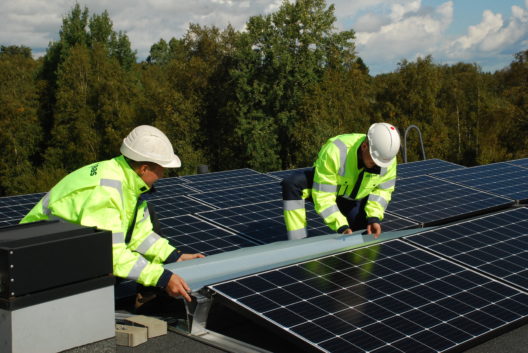Sluggish pace of network operators hinders the use of solar energy
An overview provided by Eesti Gaas shows that companies have become more interested in solar energy production, but network operators and government agencies are slow to come on board, which hiders faster and wider implementation of solar solutions. 
Margus Kaasik, member of the board of Eesti Gaas, says that by the end of October, the company had about a dozen projects where work was in progress to cover nearly five thousand square metres of building roofs or green areas with solar panels. “We started offering the solar energy solution to companies earlier this year, and, although enterprises take active interest in producing energy themselves, the actual implementation of the solutions is hindered by bureaucracy and the sluggish pace at which network operators process things,” Kaasik said.
“While we can essentially complete the design and the solution in a month, updating the consumers’ conditions of connection to the network adds at least two more months to the schedule, which dampens the interest of the companies and prolongs the period it takes for the works to be completed,” the member of the board of Eesti Gaas added. “An alternative should be found for the current situation in which network operators process the solutions meant for small-scale companies and consumers in the same queue as large-scale production facilities, which puts small-scale solutions on hold for an unreasonably long time.”
Priit Keskla, member of the board of Pruuna Mõis OÜ, which was among the first companies to have opted for solar energy solutions, stated that they decided to start producing energy independently in order to decrease environmental pollution and also to see a significant reduction of costs. “We are planning to install solar panels to cover a major share of energy consumption at our board and care facility, and it will allow us to save considerably on network service fees alone.” He added that the environmental aspect is no less important. “Electricity generated from oil shale cannot be taken seriously or regarded as sustainable these days.”
“We opted for the zero-expense solar energy solution exactly because it will not require additional investments from us, and the provider of the solution is dealing with all the necessary documentation and construction. Even finding the suitable location for the installation of solar panels in the manor garden and obtaining approvals from the Environmental Board has taken the contractor several months,” Keskla noted.
Eesti Gaas started offering solar power solutions to companies, public buildings and apartment owners’ associations in July. The solution implies setting up a solar power plant for the client without any additional expenses on the client’s part, after which the electricity it generates will be sold to the client, who will be saving on network service fees. By now, Eesti Gaas has signed the respective contracts with companies and institutions from a variety of sectors: business facilities, care homes, manors. The solar energy solution will allow the client to cover about 40% of their total energy needs.
The new energy solution is primarily meant for the companies, apartment owners’ associations as well as schools or kindergartens whose electricity consumption is at least 20,000 kWh. The installation of solar panels requires at least 400 m2 of free space on the ground or roof. When installed in the best available location, a 1-kW unit can generate nearly 1000 kWh of electricity per year.
The installation of solar panels is performed by EG Ehitus, a subsidiary of Eesti Gaas. The solution features high-efficiency polycrystalline and monocrystalline panels to condense energy production in as small an area as possible.

